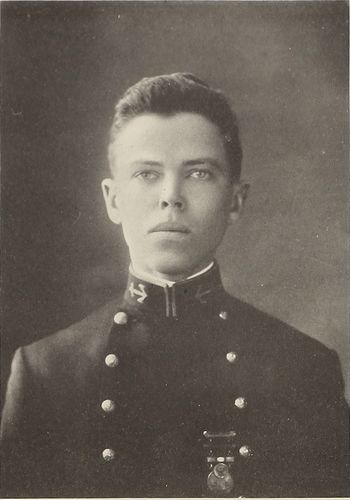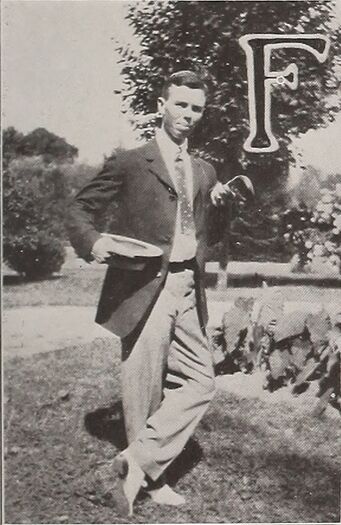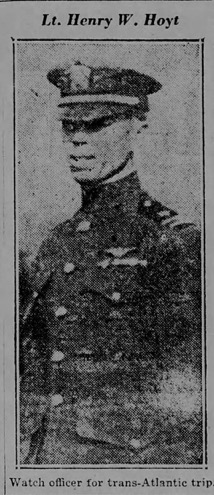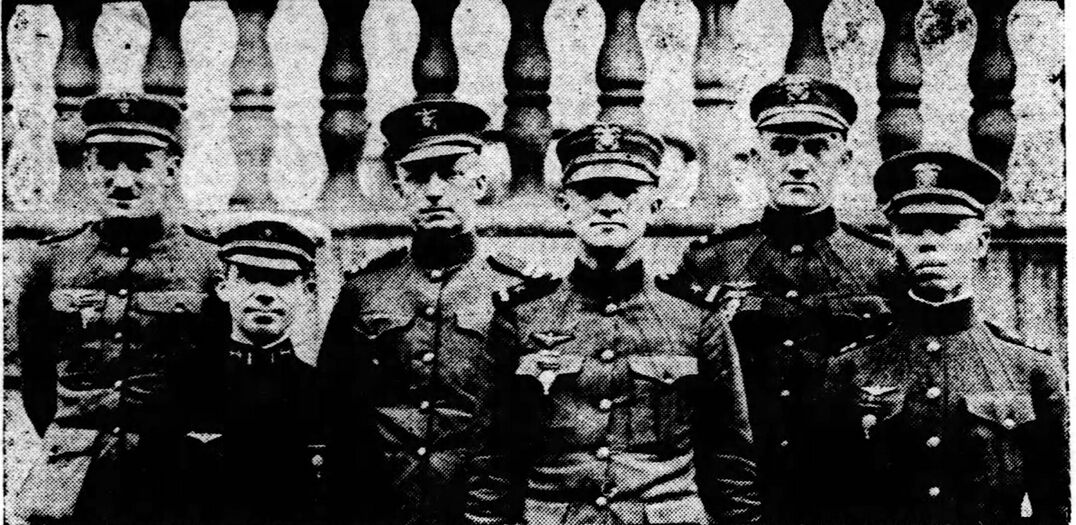HENRY W. HOYT, LT, USN
Henry Hoyt '14
Lucky Bag
From the 1914 Lucky Bag:
Henry Willet Hoyt
Clearwater, Florida
"Susie"
FRESH from the Everglades of Florida! and the oldest man in the class! He turns out at 4:00 a.m. while on leave in order to play with the green crocodiles in his backyard, before the sun comes up. Alligator pears and rattlesnake chops are not delicacies to him, but just plain, ordinary necessities of life.
Susie is the hardest working man in the class. The lower his marks get, the harder he works. On the ragged edge more times than one, Susie has kept in the swim by his steady, persistent plugging. He doesn't know what it is to say, "I can't do it." He tackles the fiercest fighter in the class with the same readiness with which he tackles a problem in thermodynamics. Do not jokingly question his standards of character or you'll have a job on your hands.
Susie is a man who holds his word supreme. If he tells you anything, it's true; when he promises to do a thing, he'll do it. One year, Susie promised a fellow a ticket for The Game. When the time came round he wanted that ticket more than anything else at that time,—except a Navy victory. And yet, rather than break his promise, Susie sacrificed his own wishes for the pleasure of another, showing us that his character is one of the highest in the class.
He had quite a time second class cruise trying to subdue his hammock and had to call on the anchor watch to help him a little one night in New York. He said it was a nightmare. It was — for the rest.
What he gets, he owes not to any favors, but to his own efforts. A sincere friend,—a constant lover,—and a true man,—Susie Hoyt.
"Why say," old man, "want some dances?"
Hinder (8th Co.); Sharpshooter; Expert Pistol Shot; Crew Squad (4, 2, 1) ; Choir (4, 3, 2, 1).

Henry Willet Hoyt
Clearwater, Florida
"Susie"
FRESH from the Everglades of Florida! and the oldest man in the class! He turns out at 4:00 a.m. while on leave in order to play with the green crocodiles in his backyard, before the sun comes up. Alligator pears and rattlesnake chops are not delicacies to him, but just plain, ordinary necessities of life.
Susie is the hardest working man in the class. The lower his marks get, the harder he works. On the ragged edge more times than one, Susie has kept in the swim by his steady, persistent plugging. He doesn't know what it is to say, "I can't do it." He tackles the fiercest fighter in the class with the same readiness with which he tackles a problem in thermodynamics. Do not jokingly question his standards of character or you'll have a job on your hands.
Susie is a man who holds his word supreme. If he tells you anything, it's true; when he promises to do a thing, he'll do it. One year, Susie promised a fellow a ticket for The Game. When the time came round he wanted that ticket more than anything else at that time,—except a Navy victory. And yet, rather than break his promise, Susie sacrificed his own wishes for the pleasure of another, showing us that his character is one of the highest in the class.
He had quite a time second class cruise trying to subdue his hammock and had to call on the anchor watch to help him a little one night in New York. He said it was a nightmare. It was — for the rest.
What he gets, he owes not to any favors, but to his own efforts. A sincere friend,—a constant lover,—and a true man,—Susie Hoyt.
"Why say," old man, "want some dances?"
Hinder (8th Co.); Sharpshooter; Expert Pistol Shot; Crew Squad (4, 2, 1) ; Choir (4, 3, 2, 1).
Loss
Henry was lost on August 24, 1921 when the British-built airship R-38, intended for US Navy use as ZR-2, crashed near Hull, England. Forty-four of the 49 men aboard died.
Other Information
From researcher Kathy Franz:
Henry’s home was called “Seven Oaks” near Clearwater. When his twin sister Clarine married, The Tampa Tribune, September 12, 1920, reported: “This home has been greatly admired for its natural beauty and tropical setting among the seven large oaks and numerous shrubs and flowers, many of which excel in size and rarety.”
Henry went to school in Tampa and was appointed to the Naval Academy by Congressman Sparkman in 1910.
After graduation, Henry was assigned to the USS Nebraska in June 1914. The ship had just returned from Mexico during the Veracruz occupation earlier that year. She returned to Mexico in June 1916, for over four months.
In 1919, Henry was in charge of the safety of the British dirigible, R-34. The airship broke from its moorings at the New Jersey landing field during a high windstorm. Henry was in command of several hundred American soldiers and sailors who struggled for several hours to prevent her escape.
Per The Tampa Tribune, September 23, 1919:
Lieut. Henry W. Hoyt, of Clearwater, has been commended by the naval department for his services in connection with the recent visit of the British dirigible, R-34. He was in charge of the grounds and was responsible for the safekeeping of the dirigible while it was in the United States. The letter of commendation says: “The department takes pleasure in highly commending you for the manner in which you took charge of the work of providing for the safety of the British dirigible R-34, the first aircraft to successfully negotiate the aerial trip across the Atlantic from the east, and for the executive ability displayed by you on this occasion.” Lieutenant Hoyt has been designated by the navy department as one of the pilots for the St. Louis balloon races.
Per The St. Louis Star and Times, September 27, 1919:
Throughout the afternoon Lieut. H. W. Hoyt and Ensign F. W. Reichelderfer had been working with the third navy balloon in an effort to repair a leak. Even when it came their time to depart, and the envelope was but half filled with gas, they would not give up and continued their efforts to get the balloon started until 7 o’clock, when the flight was abandoned. . . .
The appendix of the balloon [Navy No. 3] carrying Lieut. Emerson and Ensign Sloman would not open. Few persons noticed this as the balloon ascended, but Lieut. Hoyt did and was worried. Sloman climbed on the suspension ropes and endeavored to open it. He was still working at it when the balloon passed out of sight.
Lieut. Hoyt said that there was danger of the balloon bursting if there were no means of letting out the gas as it expanded at the higher altitude or in the sun.
At Henry’s funeral, all businesses were halted for an hour in Clearwater. The Presbyterian church held the services. A male quartet sang his favorite hymn, “For All the Souls Who From Their Labors Rest.” Henry wrote his mother a few days before he died that he heard this hymn at a memorial service at Ferriby, England.
Henry’s father Robert owned an orange grove. His mother was Agnes who farmed the grove after her husband’s death. In 1910, Henry and his brother Robert worked in the grove. In 1919, Robert was in army aviation and held the high altitude flying record in WWI. Their other brother was Gustave. Their sisters were Elsie, Clarine (Mrs. Thomas Clayborne Hobbs,) and Sarah who died young. Elsie was a French teacher and later Dean of Girls at Hillsborough High School in Tampa.
From Early Aviators:
THE ARMY-NAVY and NATIONAL BALLOON RACES, 1919
In the year following the end of the Great War, St. Louis moved into its readjustment by once again turning to the aeronautic activity which had made the city one of the primary air centers in the United States. In 1919, balloon racing returned to St. Louis in the form of two significant events. They were conducted by the Missouri Aeronautical Society, the successor to the Aero Club of St. Louis.
The inter-service event was scheduled to start on September 26, 1919, from the grounds of the Missouri Aeronautical Society at Meramec Park (Formerly Priester's Park) at Grand Boulevard and Meramec Street. This contest was to be "the first of its kind ever held in this country" and it was planned as an annual affair.
Each branch of the service had entered three contestants, vying for military prestige, as well as the silver trophy, which would be awarded to the winning department.
The Naval contingent was composed of: Lieutenant H.W. Hoyt and Ensign F.W. Reichelderfer, Akron Ohio; Ensign J.H. Stevens and Lieutenant W.R. Reed, Pensacola, Florida; Lieutenant Junior Grade R. Emerson and Ensign F.L. Sloman, Washington, D.C.
Lieutenant Emerson and Ensign Sloman of Washington crossed Lake Michigan in the Navy #52, but were brought roughly to earth at 10:20 a.m. September 27, when their drag rope caught in a tree and caused the balloon to rip itself open as it came to the ground.
The Geological Survey in Washington computed the distances of the four contestants who had actually competed in the race, and on October 9 announced the results:
- Army #1 - Captain E.P. Phillips, pilot and First Lieutenant Byron T. Burt, aide. 491.8 miles to Door Peninsula, Michigan.
- Navy #52 - Lieutenant R. Emerson, pilot and Ensign F. L. Sloman, aide. 486.4 miles to a point two miles northwest of Stittsville, Michigan
- Navy #50 Ensign J.H. Stevens, pilot and Lieutenant W.R. Reed, aide. 479 miles to a point four miles north of Menominee, Michigan.
He is buried in Florida.
Photographs
"Front row: Lieut. H. W. Hoyt, Akron, pilot: Ensign J. H. Stephens, Pensacola, pilot, and Lieut R. Emerson, Washington, pilot. Rear row: Ensign F. W. Reichelderfer, aid to Lieut. Hoyt; Lieut. W. B. Reed, aid to Ensign Stephens, and Ensign F. L. L. Sloman, aid to Lieut Emerson." From the St, Louis Post Dispatch on September 25, 1919.
From Home of Heroes:
The Navy Cross is awarded to Lieutenant Henry W. Hoyt, U.S. Navy, for heroism and devotion to duty in the line of his profession, while serving on the U.S.S. Huntington, when that vessel arrived in the war zone on September 17, 1917, he went up as observer in a captive balloon, known to be of an unsatisfactory type, and notwithstanding the danger, remained in the balloon during rain squalls followed by a stiff breeze, which caused the balloon to descend and deflate, rendering it unstable. The balloon was reeled in, but rolled about and pitched violently, injuring the observer, and finally the basket dragged under water. Lieutenant Hoyt was finally rescued from his desperate position by an enlisted man who went overboard from the ship.
Hoyt, Henry W.
Lieutenant, U.S. Navy
Balloon Observer, U.S.S. Huntington
Date Of Action: September 17, 1917
More information on this event is available in November 1918 issue of "Flying".
Detailed Career Information
His personnel information card, from sometime before his death:
Naval Aeronautic Station, Pensacola , Fla., for instruction 1/2/17-6/2/17
To duty on the Charleston, 6/4/17-8/9/17
Tempo duty on the Huntington, 8/13/17-12/8/17
Tempo duty Receiving Ship at New York N.Y., 12/10/17-1/21/18
Aviation duty at the Naval Air Station, Rockaway, L.I., 1/21/18-1/21/18
To Naval Air Station, Pensacola, Fla., 1/24/18-4/22/18
To Naval Air Station, Hampton, Roads, Va., 4/28/18-8.6/18
To tempo duty Navy Dept., Wash. D.C., 8/8/18-8/23/18
To Naval Aviation Detachment, Akron, Ohio, 8/23/18-4/25/19
He was promoted to Ensign upon his graduation on June 6, 1914; Lieutenant(jg) on June 6, 1917; Lieutenant (temporary) on October 15, 1917; Lieutenant (permanent) on June 6, 1920.
Memorial
On July 2, 1943, at a celebration for the christening of the newest Goodyear-built K ship, Henry and eight other men lost in lighter-than-air flight were honored with a memorial tablet on a granite rock at the Wingfoot Lake station at Suffield, Ohio. The other honorees were: CDR Louis Maxfield '07, on the British ship ZR-2 in 1921, LCDR Zachary Lansdowne '09 in the Shenandoah crash in 1925, LT Charles Bauch on the U.S.S. Akron in 1931, LCDR Emory Coil '12 in 1921, LT Arthur R. Houghton in 1925, LT J. B. Lawrence in 1925, LT C. G. Little in 1921, and LT Frank Trotter '23 in 1942.
Related Articles
Lewis Maxfield '07, Valentine Bieg '10, and Emory Coil '12 were also lost when ZR-2 crashed.
The "Register of Commissioned and Warrant Officers of the United States Navy and Marine Corps" was published annually from 1815 through at least the 1970s; it provided rank, command or station, and occasionally billet until the beginning of World War II when command/station was no longer included. Scanned copies were reviewed and data entered from the mid-1840s through 1922, when more-frequent Navy Directories were available.
The Navy Directory was a publication that provided information on the command, billet, and rank of every active and retired naval officer. Single editions have been found online from January 1915 and March 1918, and then from three to six editions per year from 1923 through 1940; the final edition is from April 1941.
The entries in both series of documents are sometimes cryptic and confusing. They are often inconsistent, even within an edition, with the name of commands; this is especially true for aviation squadrons in the 1920s and early 1930s.
Alumni listed at the same command may or may not have had significant interactions; they could have shared a stateroom or workspace, stood many hours of watch together… or, especially at the larger commands, they might not have known each other at all. The information provides the opportunity to draw connections that are otherwise invisible, though, and gives a fuller view of the professional experiences of these alumni in Memorial Hall.
January 1916
January 1917
March 1918
January 1919
January 1920

The "category" links below lead to lists of related Honorees; use them to explore further the service and sacrifice of alumni in Memorial Hall.


